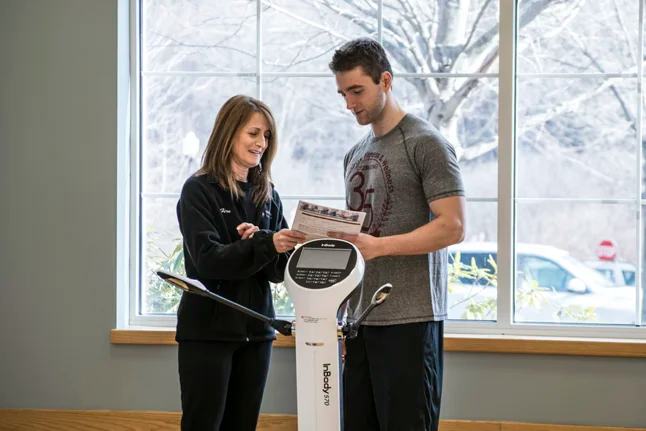Understanding your body composition is essential for achieving optimal health and fitness goals. Traditional methods often require visits to clinics or gyms, but advancements in technology now make it possible to perform In-Body Analysis at Home in Abu Dhabi. This innovative approach allows individuals to monitor their health metrics conveniently and accurately without leaving their residence. This guide aims to provide detailed insights into what in-body analysis entails, how it works at home, interpreting the results effectively, and maximizing its benefits for your health journey.
What is In-Body Analysis?
Definition and Purpose
In-body analysis refers to a comprehensive assessment of various body composition metrics, including fat percentage, muscle mass, water content, and bone density. The primary purpose is to gain a clear understanding of your physical health, track progress over time, and tailor fitness or nutrition plans accordingly. This analysis goes beyond the traditional scale measurement by providing detailed data that reflect your body’s internal composition.
Traditional vs. At-Home Methods
Traditional in-body analysis typically involves specialized equipment found in clinics or gyms, operated by trained professionals. However, the advent of portable devices and smart technology has revolutionized this process, making it accessible at home. These devices use bioelectrical impedance analysis (BIA) technology to measure body metrics quickly and accurately, offering a convenient alternative to clinical settings.
How Does In-Body Analysis at Home Work?
The Technology Behind Home Devices
Home in-body analysis devices generally employ BIA technology, where a small electrical current passes through your body. By measuring the resistance encountered, the device estimates body composition parameters. These gadgets are designed to be user-friendly, often connecting to smartphones or tablets via apps for real-time data display and tracking.
Setting Up and Using the Device
To ensure accurate results, proper setup and usage are crucial. Users typically need to stand on the device barefoot, ensuring good contact with electrodes. Consistency in measurement conditions—such as time of day, hydration level, and recent activity—is essential for reliable tracking. Instructions provided by the manufacturer serve as a guide for optimal use.
Benefits of In-Body Analysis at Home in Abu Dhabi
Convenience and Accessibility
One of the most significant advantages is the convenience of performing assessments at home. This eliminates the need for appointments, travel, and waiting times, making it easier to incorporate regular monitoring into daily routines. Particularly in Abu Dhabi, where busy lifestyles are common, this approach saves valuable time.
Personal Health Monitoring
Regular self-assessment empowers individuals to take charge of their health. It helps detect changes early, enabling proactive adjustments to diet and exercise plans. For those managing chronic conditions or undergoing weight management programs, consistent monitoring is vital for success.
Data-Driven Decision Making
Accurate body composition data informs better decision-making regarding nutrition, fitness, and lifestyle choices. It ensures that efforts are targeted effectively, whether the goal is muscle gain, fat loss, or overall health improvement.
Interpreting In-Body Analysis Results
Key Metrics Explained
Understanding the various metrics provided by in-body analysis is fundamental to making sense of your results:
- Body Fat Percentage: Indicates the proportion of fat in your body, essential for assessing overall health.
- Muscle Mass: Reflects the amount of skeletal muscle, important for strength and metabolic rate.
- Total Body Water: Shows hydration levels, which are crucial for bodily functions.
- Bone Mass: Represents bone density, relevant for bone health.
- Basal Metabolic Rate (BMR): The number of calories your body needs at rest to maintain basic functions.
How to Read the Results
Results are typically presented in numerical form along with visual graphs or charts. Comparing these with standard healthy ranges can help identify areas needing improvement. It’s important to consider trends over multiple measurements rather than isolated data points to assess progress accurately.
How to Understand In-Body Analysis at Home Results
Interpreting your results involves recognizing what each metric signifies relative to your health goals. For example, a decreasing body fat percentage coupled with increasing muscle mass indicates positive progress. Tracking changes over time provides insight into the effectiveness of your fitness regimen, guiding necessary adjustments. Utilizing app features that track historical data can help visualize your journey and motivate continued efforts.
Tips for Maximizing the Effectiveness of Home In-Body Analysis
Consistency is Key
Perform measurements at the same time each day, preferably in the morning after waking up and before eating or drinking. Consistency minimizes variability and ensures more accurate tracking.
Maintain Proper Hydration
Since water levels influence BIA measurements, staying properly hydrated before testing leads to more reliable results. Avoid excessive drinking or dehydration prior to assessment.
Combine with Other Health Metrics
In-body analysis should be part of a holistic health approach. Pair it with other measurements like blood pressure, heart rate, and physical activity logs for comprehensive insights.
Use Data to Set Realistic Goals
Utilize your body composition data to establish achievable objectives. Regularly review your progress and modify your diet and exercise plans accordingly to stay motivated.
Choosing the Right In-Body Analysis Device for Home Use
Features to Consider
When selecting a device, look for user-friendly interfaces, compatibility with smartphones, multiple measurement capabilities, and reliable accuracy. Some devices also offer personalized recommendations based on your data.
Maintenance and Care
Proper maintenance, including regular cleaning and correct storage, ensures longevity and accuracy of your device. Follow the manufacturer’s instructions for calibration and updates.
Frequently Asked Questions (FAQs)
1. How often should I perform in-body analysis at home?
For optimal tracking, performing the analysis once a week or bi-weekly is recommended. This frequency allows you to monitor trends without becoming overly fixated on daily fluctuations.
2. Can I rely solely on in-body analysis results for health decisions?
While in-body analysis provides valuable insights, it should complement other health assessments and professional advice. It is a practical tool for tracking progress and motivating behavior changes.
3. Are home in-body analysis devices accurate enough for serious health monitoring?
Modern devices utilizing BIA technology are quite accurate for general health and fitness tracking. However, their precision may vary based on device quality and usage consistency.
4. What should I do if my results show undesirable changes?
If you notice unfavorable trends, reassess your diet, exercise, and hydration habits. Consider consulting a health professional for personalized guidance and to interpret your data in context.
In conclusion, In-Body Analysis at Home Abu Dhabi offers a convenient and effective way to stay informed about your body composition and overall health. By understanding how to interpret your results and maintaining consistent monitoring, you can make informed decisions that support your fitness and wellness objectives, paving the way for a healthier lifestyle.




